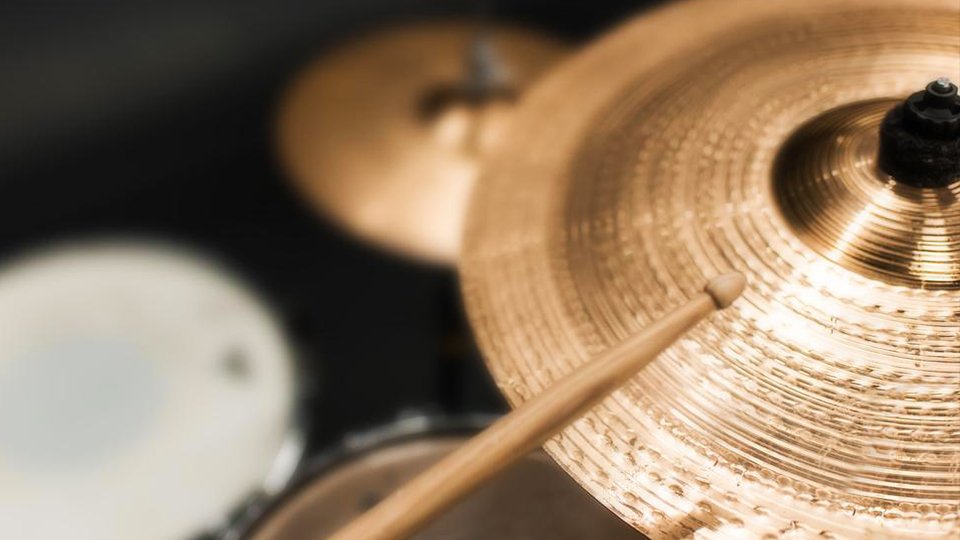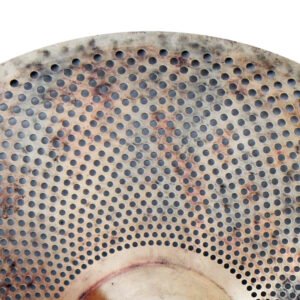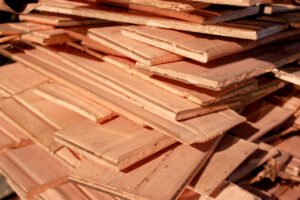When you’re examining a cymbal’s composition, you’ll find that it’s more than just a shaped piece of metal. The foundation of most modern cymbals is bronze alloy, with B20 (80% copper, 20% tin) being the industry standard. You’ll also encounter B8 bronze and brass variants, each offering distinct sonic properties. The metallic makeup directly influences everything from the initial attack to the decay pattern, making material selection essential for achieving your desired sound.
Key Takeaways
Most professional cymbals are made from B20 bronze, a metal alloy consisting of 80% copper and 20% tin.
Budget cymbals often use brass (70% copper, 30% zinc) or B8 bronze (92% copper, 8% tin).
Specialty cymbals may incorporate unique metals like silver, gold, aluminum, or titanium for specific sound characteristics.
The metal composition directly affects sound quality, with bronze alloys producing richer, more complex tones than brass.
Cymbal manufacturing involves casting metal ingots, then shaping through heating, hammering, and lathing processes.
The Ancient History of Cymbal Materials
Although early cymbal making techniques remain somewhat mysterious, archaeological evidence reveals that ancient civilizations primarily used bronze alloys containing 80% copper and 20% tin. You’ll find that these ancient cymbal origins trace back to early metalworking developments in Mesopotamia, China, and Turkey, where craftsmen discovered that this specific bronze ratio produced ideal acoustic properties.
The historical material use evolved as metalworkers experimented with different alloy compositions. You’ll notice that early Egyptian cymbals contained higher copper content, while ancient Roman specimens featured slightly more tin. These variations affected the instruments’ durability and sound characteristics. When examining archaeological specimens, you can observe how the grain structure of these early bronze alloys influenced their acoustic properties. The ancient craftsmen learned that proper heating and cooling cycles during manufacturing created the crystalline metal structure necessary for producing rich, resonant tones that we still aim to achieve today.
Understanding Bronze Alloys in Modern Cymbals

When examining modern cymbal manufacturing, you’ll find that B20 bronze remains the industry standard, consisting of 80% copper and 20% tin – a ratio remarkably similar to ancient formulations. This alloy provides ideal sound characteristics through its molecular structure and acoustic properties.
You’ll encounter other bronze compositions in modern cymbals, including B8 (92% copper, 8% tin) and B12 (88% copper, 12% tin). Each alloy produces distinct tonal qualities: B20 delivers complex overtones and warmth, while B8 offers brighter, more focused sounds. The tin content directly affects the cymbal’s brittleness and durability.
Understanding your cymbal’s alloy composition helps inform proper cymbal care. B20’s higher tin content makes it more susceptible to cracking, requiring gentler playing techniques and careful maintenance. When cleaning, you’ll need to evaluate your cymbal’s specific alloy – B8 cymbals typically tolerate more aggressive maintenance techniques than their B20 counterparts.
Common Metal Compositions Used Today
Modern cymbal manufacturers rely on three primary bronze alloys: B20, B8, and B12, with each offering distinct sonic characteristics and physical properties. B20, containing 80% copper and 20% tin, produces warm, complex tones and is favored in professional-grade cymbals. B8, with 92% copper and 8% tin, delivers brighter, more cutting sounds and enhanced cymbal durability at a lower cost.
The intermediate B12 alloy, comprising 88% copper and 12% tin, bridges the gap between B20 and B8, offering balanced characteristics. Metal sourcing plays an essential role in maintaining consistent quality, with manufacturers carefully selecting copper and tin suppliers. Additional trace elements like silver or phosphorus may be incorporated to fine-tune the alloy’s properties. The casting and forging processes are equally important, as they determine how these metals will respond to hammering and lathing, ultimately affecting the cymbal’s sound signature.
How Different Metals Affect Sound Quality
You’ll find that B20 bronze alloy (80% copper, 20% tin) produces bright, complex overtones with pronounced high frequencies and sharp attack due to its crystalline grain structure. Steel cymbals generate harsh, penetrating sounds with less warmth than bronze due to their higher tensile strength and reduced molecular flexibility. Brass cymbals, typically composed of 70% copper and 30% zinc, deliver midrange-focused tones with less sustain than bronze, making them suitable for entry-level instruments where cost efficiency matters more than tonal sophistication.
Bronze Alloy Sound Characteristics
The key component affecting a cymbal’s sonic character lies in its bronze alloy composition, with different metal ratios producing distinct tonal qualities. You’ll find that traditional B20 bronze (80% copper, 20% tin) offers superior bronze resonance and bright overtones, making it ideal for professional-grade cymbals.
When you’re exploring cymbal options, you’ll notice B8 bronze (92% copper, 8% tin) delivers a brighter, more focused sound with enhanced alloy durability. This composition’s higher copper content creates shorter sustain and more immediate attack. Meanwhile, B15 bronze (85% copper, 15% tin) presents a middle ground, providing warm undertones while maintaining clarity. The molecular structure of these alloys directly influences their projection, sustain, and frequency response, with higher tin content generally resulting in more complex harmonics.
Brass vs. Steel Effects
While bronze remains the premium choice for cymbals, brass and steel alternatives offer distinct sonic properties at different price points. You’ll find that brass cymbals produce warmer, softer tones with less sustain and projection than bronze. Brass advantages include lower manufacturing costs and greater durability, making them ideal for student drummers and practice settings.
Steel cymbals generate bright, cutting tones with pronounced high frequencies and extended sustain. However, steel disadvantages include limited tonal complexity and excessive harshness at higher volumes. The material’s rigid molecular structure results in less nuanced overtones compared to brass or bronze. When choosing between these metals, consider that brass cymbals typically contain 70% copper and 30% zinc, while steel cymbals use various alloys of iron and carbon for different sound characteristics.
Manufacturing Process and Metal Treatment
Modern cymbal manufacturing begins with precise casting of bronze alloy ingots, typically containing 80% copper and 20% tin for B20 bronze, though ratios vary between manufacturers. You’ll find that metal forging transforms these ingots through repeated heating and hammering, which compresses and aligns the metal’s grain structure for peak resonance and durability.
The metal treatment process includes several critical stages. First, the bronze is heated to specific temperatures that alter its crystalline structure. Then, it’s shaped through rolling mills to achieve the desired thickness profile. After shaping, manufacturers apply hand or machine hammering patterns that influence the cymbal’s fundamental pitch and overtones. The final steps involve lathing, where concentric grooves are cut into the surface, and cymbal polishing to achieve the desired finish – whether brilliant, traditional, or raw. Heat treatment between these stages helps relieve internal stresses and guarantees the metal maintains its acoustic properties.
Specialty Alloys and Experimental Materials
Beyond traditional B20 bronze, cymbal makers have explored numerous specialty alloys to achieve distinct tonal characteristics. You’ll find cymbals made from B8 bronze (92% copper, 8% tin), which produces brighter tones, and B15 bronze (85% copper, 15% tin) that offers a middle-ground sound profile. Some manufacturers have experimented with nickel-silver alloys and brass variations for unique sonic properties.
Recent alloy innovations include proprietary mixtures incorporating small amounts of silver, gold, or exotic metals. You’ll see experimental techniques using layered metals, where different alloys are bonded together to create complex harmonics. Some makers have developed aluminum-based cymbals for lighter weight and distinctive overtones. There’s also growing interest in titanium alloys, which offer exceptional durability and cutting projection. These specialty materials often require unique manufacturing processes, as they respond differently to hammering and lathing than traditional bronze.
Choosing the Right Cymbal Based on Metal Type
Selecting the ideal cymbal material requires understanding how different metal compositions affect sound characteristics. When you’re choosing cymbals, the metal type greatly impacts tone, sustain, and projection. B20 bronze (80% copper, 20% tin) offers bright, complex overtones with excellent projection, while B8 bronze (92% copper, 8% tin) produces sharper, more focused sounds. Your cymbal selection tips should align with your playing style and musical genre.
- B20 bronze delivers professional-grade richness and warmth, ideal for jazz and studio recording
- B8 bronze provides cutting power and durability, perfect for rock and metal genres
- Brass cymbals offer budget-friendly options with decent projection but less tonal complexity
- Nickel silver alloys produce unique bright tones with quick decay, suited for specialized effects
Consider these metal type advantages when selecting cymbals: higher tin content creates darker tones, while lower tin percentages yield brighter, more aggressive sounds. Each alloy’s hardness affects durability and attack characteristics.
Conclusion
You’ll find that modern cymbals, like your smartphone’s sleek design, rely heavily on precise metallurgical compositions. The B20 bronze alloy (80% copper, 20% tin) remains the industry standard, delivering ideal molecular density for superior resonance. While B8 and brass variants offer cost-effective alternatives, their atomic structures produce distinct harmonic profiles. For peak acoustic performance, manufacturers continue experimenting with titanium-infused alloys and specialized heat treatments.



